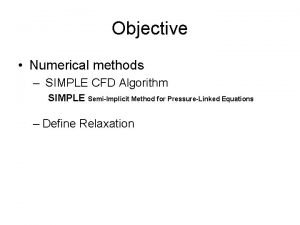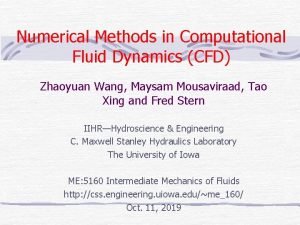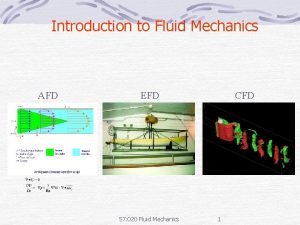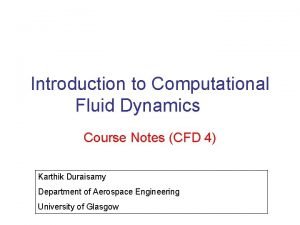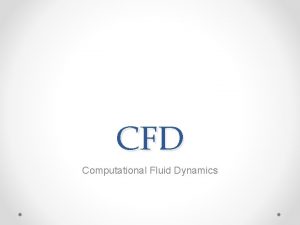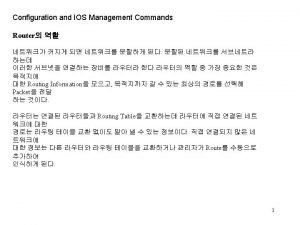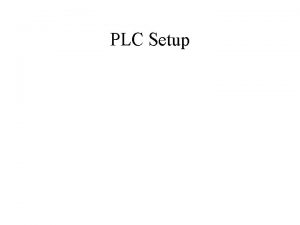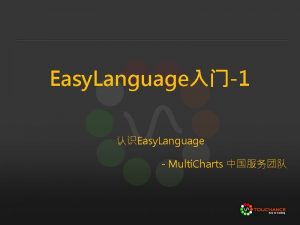CFD Project Using Easy CFD to Setup and











- Slides: 11

CFD: Project Using Easy. CFD to Setup and Run a CFD Analysis

CFD Project Overview Laminar Unsteady Flow • Goal: Learn how to setup and run your own CFD analysis • Steps 1. 2. 3. 4. Download Easy. CFD (free trial version is available) Follow the Video Tutorial provided as part of this Lecture Series Setup a 2 nd analysis using a geometry you create Write up a Report Note: review this entire PPT before starting on the project

Easy. CFD Download • Navigate to: http: //www. easycfd. net/index_files/Page 551. htm • Download the Trial Version of Easy. CFD • Install Easy. CFD • Only compatible with Windows Operating Systems

Easy. CFD Example Simulation • On the USMAthematics CFD Lecture website you will find a tutorial video which will provide step by step instructions to complete an analysis of the flow field around an obstacle. http: //usmathematics. com/wp/cfd-lecture/ Be aware that the Trial Version does not allow you to save your project. So make notes and take screenshots when appropriate

Easy. CFD Create your own Simulation • Once you have completed the example problem, explore the software a bit more to become familiar with the various tools and options, specifically the geometry creation tools. • Once familiarized, follow the example analysis again, but create your own unique geometry. • Point Scale: • 80 Points: Completing the example analysis • 85 Points: Completing the example analysis and an additional analysis using a simple geometry (ex. triangle, square, etc. ) • 100 Points: Completing the example analysis and an additional analysis using a complex/unique geometry

Write and Submit your Report • Write up a short report detailing your experience. Discuss the following: • • • The workflow, including any issues following the tutorial What steps you took to better learn about Easy. CFD capabilities The geometry you selected and why Any challenges creating or meshing the geometry Any issues with solving the CFD analysis with your geometry Please include images from both the example problem and your own geometry, including images of the mesh and images of the CFD solution. • Please submit reports to Dr. Hromadka ted@phdphdphd. com

Sample Geometry for 100 Points (Do Not Duplicate)

Potential Issues with Complex Geometry • Complex geometries can create issues during the meshing step. These issues can manifest as warnings during the meshing or in a lack of solution convergence when solving. • Below are some warnings and automatic correction messages you may see when meshing the geometry you created. If offered an automatic correction, click “Yes to All” or “Yes”. The specifics of these errors are beyond the scope of this lesson but take note of the importance of meshing to ensuring a successful CFD simulation. • A warning may or may not need correction. Try running the solver first. If convergence is an issue, you may want to try refining the mesh per the instructions in the following slides.

Solution Convergence • Complex geometries and geometries leading to unsteady flow (like the example) can lead to errors when trying to find a solution to the CFD analysis. A common cause is divergence of the residuals. If this happens, you will see the following warning message. An example of diverging residuals is also shown. • There a couple reasons this error could occur. The flow regime could be unsteady, thus there is no single answer so the residuals will not converge. However, even unsteady flow problems may not lead to residual divergence if the mesh is refined or if the time step of the simulation is reduced. The probable solution to this issue is to refine the mesh (refer back to the Video for how to refine the mesh) or decrease the size of the timestep. • If the solver executes, you may also see a warning that “the convergence criteria has not been reached”, this is especially true if the geometry is creating unsteady flow conditions. For the purpose of this exercise this warning may be ignored.

Boundary Condition Issues • After successfully conducting a CFD analysis, you may see the below warning. This means that the model domain is not large enough to capture all the flow field effects and that the boundaries of the model are influencing the results. The fix in this case would be to increase the size of the domain and move the boundaries away from the created geometry. However, for this exercise it is enough to make note of the issue.

Note: • In industrial applications of computational engineering mathematics (CEM) related software packages, such as demonstrated by our example problem, one typically encounters limitations of the CEM software, usually from high levels of discretization and computational matrix solution difficulties and the like. Be aware of the software underpinnings and be cautious in assuming that you have a "correct" solution simply because the software "ran" and you have a computational solution in hand. This particular topic is beyond the scope of the current class, but this type of assessment can be found in the current literature as well as in graduate courses. The course web page includes assessment topics of CEM modeling accuracy issues under the general topic of RESEARCH.
 Deductive reasoning
Deductive reasoning Every quiz has been easy. therefore the test will be easy
Every quiz has been easy. therefore the test will be easy Example of a deductive argument
Example of a deductive argument How to write a logbook for a science project
How to write a logbook for a science project Kitchen math: measuring worksheet answers
Kitchen math: measuring worksheet answers Sales force mobility
Sales force mobility Multicard agip
Multicard agip Cfd expert
Cfd expert Navier-stokes equation derivation
Navier-stokes equation derivation What are numerical method in cfd
What are numerical method in cfd Fluid mechanics
Fluid mechanics Fluid dynamics notes
Fluid dynamics notes








